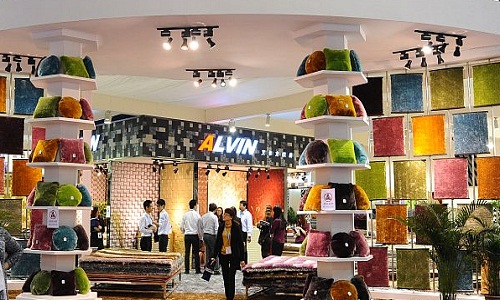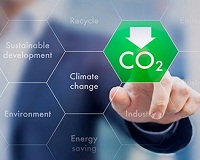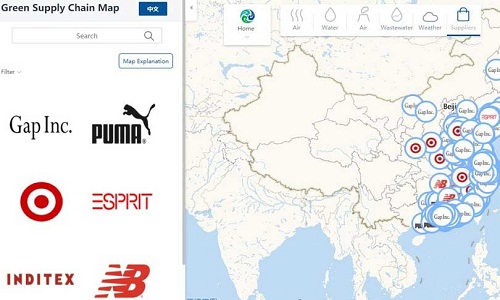FW
More than 100 Sinosky Hejun Garment Co Ltd workers resorted to strike in Phnom Penh for a full four hours yesterday to urge the company to take back their leader Kim Chetra and allow him to get back to work. The concerned person was fired last month for forming a union.
Mom Seak, president of the Khmer Union Federation of Workers Spirit, said that the workers were demanding that Chetra be allowed to return to work since he was fired unjustly. The company fired their leader who had recently formed a union at the factory, he said.
He added that the union was formed to help workers experiencing problems. The Chinese-owned garment factory, located in the capital’s Por Sen Chey district, makes clothing such as pants, shirts, shorts and tank-tops.
The textile industry of Pakistan has been using every government forum to influence Prime Minister Nawaz Sharif to announce a Rs. 200 billion grant for the upgrading of the textile industries. The industry already enjoys uninterrupted electricity and gas supply.
The particular industry enjoys these benefits on their claims to be the biggest export and job creating industry of Pakistan, but in reality, Pakistan’s exports are on the downslide. The country seems to be importing more textile products than exporting. The industry is also the worst tax-paying sector.
Interestingly a few textile industrialists have been named in Panama leaks having off-shore accounts containing millions of dollars. But, they have been declaring losses for the last many years.
Financial incentives should be withdrawn from the textile sector as it is a very old and established industry and instead the budget should be utilised in setting up new industries in Pakistan or to improve agriculture. It should especially be used for the cotton plantation industry which has one of the lowest yields for cotton farms in the region. A policy, whereby all incentives allowed to an individual industry should not be higher than 75 per cent revenue received to the government should be established to ensure Pakistan’s budget is not wasted on the failing industries.
State Bank of Pakistan (SBP) Governor Arshad Wathra on Tuesday reiterated the government’s resolve to revive the textile industry and pledged explicit support for all the stakeholders. He was addressing the Senate Standing Committee meeting on Textile Industry.
He asked the representatives of the banking sector to play their due role in rehabilitating the textile industry by extending loans to the exporters. He further said that it was a moral responsibility of the entire business community to bring back their foreign assets and liquidity so that the alarming situation of the textile industry could be neutralised. The meeting was held to highlight the problems duly faced by the textile industry in the country and proposals for its sustainability.
One of the members of the committee, Senator Nihal Hashmi, drew the attention of the members to the monopoly of private banks in terms of advancement of loans and urged that private banks should have been stringently regulated by the SBP. He further said that the government alone would not be able to bail out the textile industry. Rather the private sector would also have to come forward and extend financial support to the textile industry.
Expressing the concerns of the banking sector, Nauman Dar, the representative of the Habib Bank of Pakistan, said that the textile industry would have to prove its competiveness if they seriously expect the banking sector to come for their rescue. He further said that the government would have to offer subsidies to the exporters. Expressing his optimism about the future and potential of the textile industry in Pakistan, he said that the textile industry in the country was not dead.
In his concluding remarks, Senator Mohsin Aziz, Chairman Senate Standing Committee on the Textile Industry, highlighted the significance of textile industry in the economic stability of a country and the role of banking sector in its sustainability. He said that a sustainable textile industry ensured employment and optimum benefit to agriculture sector of a country.
With mass termination reportedly continuing following the recent labour unrest in Ashulia, Bangladesh, sacked workers of apparel factories at the industrial belt are in fear of not getting a job in another workplace. Moreover, those who are still working at the factories are of the say that their employers are forcing them to work extra hours without any overtime.
Since the labour unrest, at least 1,600 workers of a particular readymade garment factory lost their jobs. Around 1,500 unnamed sacked workers were also sued in separate cases filed for inciting the unrest, leaving most of them in fear of arrest anytime now.
One such worker is Jewel who was temporarily suspended as a sewing operator of IDS Group on December 26 without any reason. With a Taka 7,099 monthly salary, he used to work in the factory along with his wife who still continues with her job there.
When the factory opened, Jewel said he found his photo, name and address on the list of sacked employees. So much was he shocked at the suspension without any explanation that he talked to the admin officer of the company. The latter said that there was no chance of him getting back to his work there and not even in Ashulia by any chance.
Claiming innocence, Jewel said that he may get arrested if he searched for a job in the area since many most of his ex-colleagues were sued. Like him, a sacked female garment worker of another factory, Asma, expressed her grief saying that she was on sick-leave during the unrest and was not even involved in it. Despite the fact, she was dismissed.
Meanwhile, the government has resorted to a crackdown on the labour leaders and labour rights activists for their alleged link to the recent unrest in the area is going on as well. Amid the situation, the central committee of Garments Sramik Adhikar Andolan, a platform of 12 labour rights organisations, has written to the National Human Rights Commission (NHRC), seeking its interference to help resolve the crisis.
"One of the most awaited trade fairs for the apparel fabric and accessory industry, Spring Edition of Intertextile Shanghai Apparel Fabrics returns from March 15-17 with close to 3,000 companies exhibiting at the fair. Going by the record number of exhibitors, an extra hall has been added. An increased number of women’s wear and accessories exhibitors, and to a lesser extent, functional fabrics suppliers, will feature at this edition. "

One of the most awaited trade fairs for the apparel fabric and accessory industry, Spring Edition of Intertextile Shanghai Apparel Fabrics returns from March 15-17 with close to 3,000 companies exhibiting at the fair. Going by the record number of exhibitors, an extra hall has been added. An increased number of women’s wear and accessories exhibitors, and to a lesser extent, functional fabrics suppliers, will feature at this edition. Four concurrent textile fairs will occupy another seven halls, providing unrivalled sourcing options for buyers from around the world.

“We are pleased with the response so far from both our existing exhibitors as well as newparticipants for this edition,” Wendy Wen, Senior General Manager, Messe Frankfurt, explained. “They recognise this fair is a place where business is still conducted over the three days, and is unrivalled in its scale and coverage of the industry, thus providing exhibitors with new opportunities at each edition. Particularly for the Spring Edition, it is the ideal industry event to reach Chinese buyers, including a number of the biggest brands.” These brands are: Bosideng, Eral, Handu, JNBY, K-Boxing and Semir. In addition to domestic buyers, visitors from around 100 countries and regions can be expected at the 2017 edition.
An unbeatable accessories’ range
The majority of overseas exhibitors will feature in the International Hall (hall 5.2), which includes a number of distinct areas:
SalonEurope: Premium European suppliers as well as the Milano Unica Pavilion and France & Germany Zones Premium Wool Zone: exhibitors from France, Italy the UK and elsewhere will showcase their high-end wool and cashmere fabrics Verve for Design: design studios from around the world will display their latest original design collections All About Sustainability: a range of companies offering sustainability products, solutions and services feature in the eco-Boutique, while this area also includes an Educational Zone and Forum Space Functional Lab: housing exhibitors with products for the high-performance activewear market Asian Pavilions: pavilions from India, Japan, Korea, Pakistan and Taiwan return to Intertextile Shanghai Group Pavilions: the Lenzing Group Pavilion will feature for the first time at the Spring Edition, while the Dyetec Pavilion will also feature a number of their partner mills
Chinese exhibitors will be in halls 6.1, 6.2, 7.1, 8.1 and 8.2, grouped by product end-use as well as in various pavilions..
Trend Forum
Intertextile Shanghai’s renowned fringe programs will once again feature information and inspirations to keep the industry ahead of the curve. The Intertextile Directions Trend Forum will be joined by a number of Chinese trend forums to display and explain the upcoming themes, colours, fabrics and prints for the spring / summer 2018 season. Leading experts and trendsetters will take part in a number of seminars and panel discussions under topics including design and trends, technology and solutions, market information and business strategies, and sustainability issues.
In addition, four other textile fairs occur concurrently in the same venue: Yarn Expo Spring (Hall 5.1), Intertextile Shanghai Home Textiles – Spring Edition (Hall 4.2), CHIC (Halls 1, 2, 3 & 4.1) and PH Value (Hall 3). Intertextile Shanghai Apparel Fabrics – Spring Edition 2017 is co-organised by Messe Frankfurt; the Sub-Council of Textile Industry, CCPIT; and the China Textile Information Centre.
When it comes to high-waisted, super black, skinny-fit jeans, Just Black is the brand to go to. This US brand sells denim for women that is a little bit thicker than normal skinny jeans and super high rise.
Customers of varying shapes and sizes love the brand. While for instance a brand like Rag & Bones may be too saggy at the waist and too tight at the ankles. Or a brand like Cheap Mondays may be a little too cropped for ankle boots.
As makers of handcrafted denim, Just Black believes each jean is sewn to mold for every type of body. Each pair is sanded by hand and hand sewn to ensure the authentic details are captured. Quality, value and comfort are all co-dependent to make the perfect pair.
The attention to detail of the stone wash, hand sanding and distressed hems are what make the brand’s denim stand out from the rest.
Each piece is created with classic workmanship. The denim collection is curated to combine modern details with versatile silhouettes creating an easy to wear jean. Luxuriously soft and stretch fabrics are used to create the most comfortable pant ever. Just Black Denim is sold in boutiques across Europe and North America.
"IPE Green Supply Chain Map links major fashion brands such as Target, Esprit, New Balance, PUMA, Gap Inc, and Inditex with their suppliers’ environmental performance. Kurt Kipka, Senior Project Manager – Responsible Sourcing Initiative, NRDC, says each brand conducts a mapping process against a database of Chinese facilities that have publicly available real-time monitoring. In most cases, the brands have already made these lists available to the general public. In that case, the map simply takes existing information and improves upon its usability."

IPE Green Supply Chain Map links major fashion brands such as Target, Esprit, New Balance, PUMA, Gap Inc, and Inditex with their suppliers’ environmental performance. Kurt Kipka, Senior Project Manager – Responsible Sourcing Initiative, NRDC, says each brand conducts a mapping process against a database of Chinese facilities that have publicly available real-time monitoring. In most cases, the brands have already made these lists available to the general public. In that case, the map simply takes existing information and improves upon its usability. Access to data is a critical step in both identifying and curtailing highly polluting practices in the textile supply chain.

Increased transparency As per NRDC and IPE, with China expanding its industrial manufacturing base, as much as 25 per cent of carbon emissions have been linked to the manufacture of products for export. Air, water, and soil pollution problems have emerged. The impact was mentioned in the Ellen MacArthur Foundation’s Circular Fibers Initiative reports as well. Heavy chemical use is involved in making other cellulose-based fibers, in particular viscose. The processes used to make these fibers extract cellulose from trees or other plants using a variety of process-specific chemicals. By connecting supplier lists with publicly available information, brands and eventually consumers can use the tool to reduce the global impact of textile manufacturing by making more informed purchasing decisions.
The IPE Green Supply Chain Map, having English and Chinese versions, offers companies real-time information to ensure environmentally responsible operations from afar. When used correctly, the IPE Green Supply Chain Map can reduce the time and expense associated with factory audits, which often don’t identify hidden problems as well.
The functionality
With the help of data from the Chinese government, IPE’s database and map show real-time data and historical trends in air pollution emissions and wastewater discharge for nearly 15,000 major industrial facilities in China. The database also has environmental supervision records for more than 500,000 additional facilities. So far, the response for the map has been good.
One of the potential advantages of the IPE Green Supply Chain Map for participating brands is just-in-time identification of potentially egregious supply chain oversight and management issues. Recognising these issues can drastically reduce the time it takes brands to collaboratively address the concerns with their business partners, added Kipka. In addition, joining the map underscores a brand’s commitment to setting and upholding standards of performance. Although the map in its early stages of development, the company hopes it inspires more companies to follow the leadership of its inaugural brands and volunteer their supply lists to the effort. The company hopes that it should also be beneficial for other countries to adopt such a map and manage their supply chain eco-measures.
The global luxury apparel market is expected to expand at a CAGR of 13.2 per cent from 2016 to 2024. Big brands such as Louis Vuitton, Prada, and Versace are expanding to developing economies, which has not only improved their geographical reach, but also won them a newer consumer base.
The global luxury apparel market is segmented into leather, cotton, denim, silk, and others. Cotton dominates the global market and it held a share of 35.87 per cent in 2015. The material has become ubiquitous in the clothing and fashion industry due to high absorbency, comfort, and the breathable nature of the fiber. High cotton production in India and China has also made Asia Pacific a frontrunner in the global market.
Leather is the next emerging segment in the global market. This material is being preferred due to its durability and ability to adapt to myriad designs that characterize high fashion. The expensive nature of leather also makes it ideal for luxury brands, who work on the premise of premium pricing of what they feel is the exceptional quality of products.
Silk is also gaining momentum due to its smooth texture, softness and the elegance it bestows on the overall design. The production of silk in India and China has also once again lent an impetus to the luxury apparel market of the Asia Pacific.
Egypt wants to have stronger trade relations with Africa. Steps include taking part in international exhibitions in the African continent and setting up an Egyptian-African free trade zone. The main countries Egypt is interested in are Kenya, Zambia and Ivory Coast.
Challenges include the weakness of the banking sector in many African countries and the poor infrastructure. In addition, the lack of maritime ports is a challenge, since many African countries are landlocked. There is also the problem of a lack of logistical centers that makes establishing permanent exhibitions for Egyptian products more difficult.
The problem is that of improving shipping lines and finding shipping lines that directly target a large number of African markets. Working to make Egypt a leading international trade center in the Middle East requires work to increase the capacities of Egyptian ports in order to attract more container ships as well as working on the development of logistics capabilities and infrastructure to support this trend.
Egypt’s main exports to Africa are engineering industries, pharmaceuticals, chemical garments, food industries, and construction materials. Egypt wants to increase exports to the African continent by 35 per cent in 2017. Other important markets for Egypt’s exports are the United States and European Union countries.
Cambodian garment exports get preferential access in markets like Canada, Japan and especially the EU. The EU is its largest export market, accounting for 45 per cent of its total garment exports. The EU grants Cambodia duty-free access under the generalized Scheme of Preferences (GSP) Everything But Arms (EBA) arrangement.
Cambodia’s total exports of garments and footwear to Japan increased by 32.7 per cent in the first half of the year, that is, January to June 2016. Cambodia has lower production costs than has Japan and so Japan doesn’t produce much of garments and footwear.
The main products that Cambodia exports to Japan are garments, footwear, sugar, fish and seafood. Imports from Japan are mainly machinery, automobiles, electronic products, beef, iron, steel and pharmaceutical products.
Companies which buy from Cambodia include H&M, Inditex, Marks & Spencer, New Look, Adidas, Nike, Levi’s and Uniqlo.
The garment industry of Cambodia earns 80 per cent of Cambodia’s foreign exchange earnings and employs an estimated 3,50,000 people in more than 300 factories.
Cambodia relies heavily on garment exports to earn foreign earnings. There are now plans to shift from low-priced garment manufacturing to higher end manufacturing of automobile, machinery and electronic parts, which will help it diversify its export basket and maintain the overall health of the economy.












